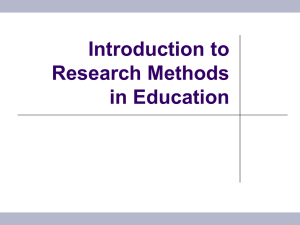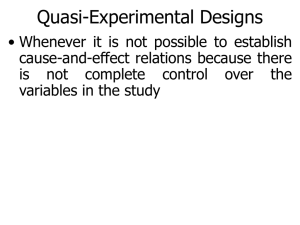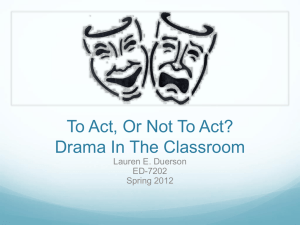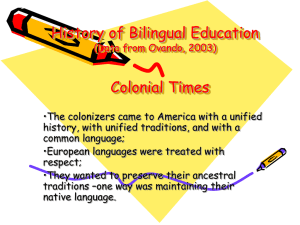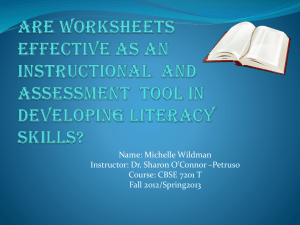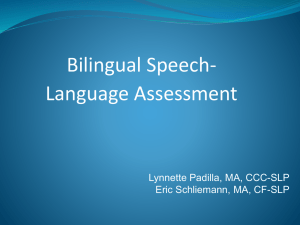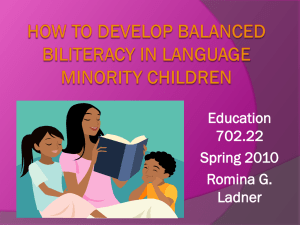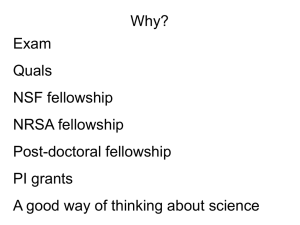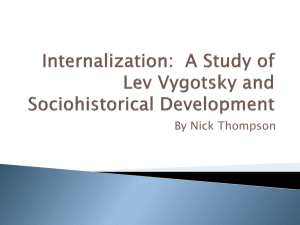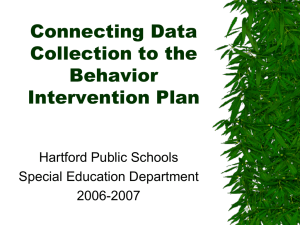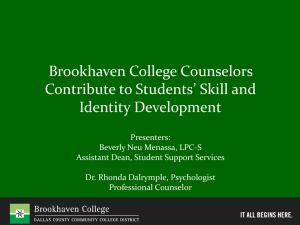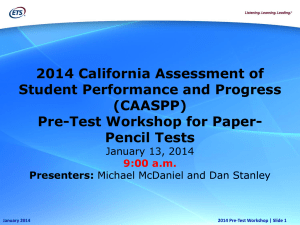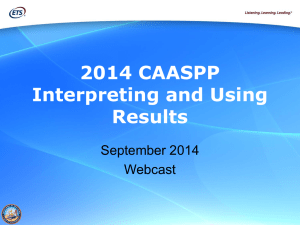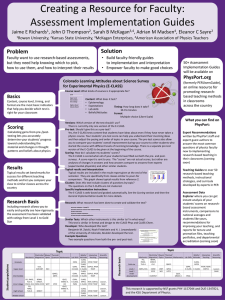Vygotsky & Krashen
advertisement
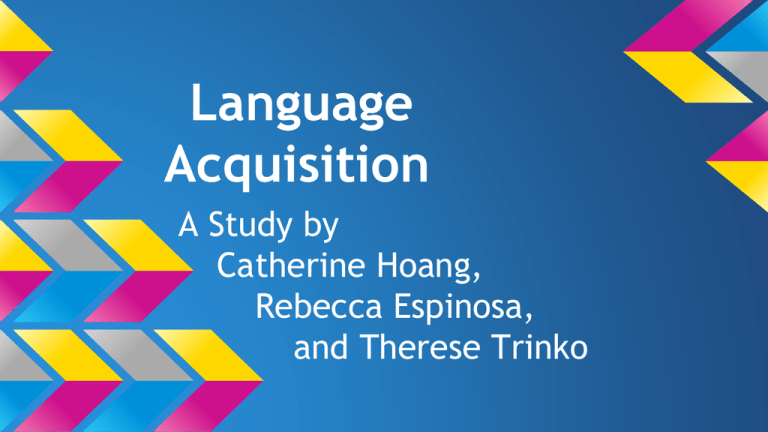
Language Acquisition A Study by Catherine Hoang, Rebecca Espinosa, and Therese Trinko Terms to Know ❖ Metacognitive skills ➢ Awareness of one’s own learning or thinking processes ❖ “Improvement” ➢ A higher score on the post-test as compared to the pre-test ❖ “Acquired” ➢ Marked the correct answer on the post-test that s/he had marked incorrectly on the pre-test Language Acquisition According to Vygotsky: “...the meaning of a given word is approached through another word, and whatever we discover through this operation is...a record of the relation in the child’s mind between previously formed families of words” Lev Vygotsky ❖ 1896-1934 ❖ Jewish ❖ Moscow University (Law) ❖ Thought and Language, ❖ Mind in Society, etc. ❖ Communist Suppression How History Shaped His Ideas ❖ ❖ Marxism ❖ Engel’s use of tools ➢ Vygotsky: Language is a tool to deal with one’s environment ➢ Individuals create psychological tools to learn, or Metacognitive Skills Vygotsky’s Theories ❖ Zone of Proximal Development ➢ an area / “zone” between the child’s ability to perform independently and with assistance, where the most effective instruction occurs. ❖ Mediation ➢ Movement from a lower form of thought to a higher form of thought ❖ Tools ➢ Language and Metacognitive skills Krashen ❖ Born in Chicago, 1941 ❖ Ph.D at UCLA in Linguistics ❖ Emeritus Professor of Linguistics and Education at the University of Southern California ❖ Published over 350 books and papers Krashen’s Theories ❖ Acquisition-Learning Hypothesis-immersion and custom -vs- formal active development ❖ Monitor Hypothesis-We use what we know of a language to self-correct/“monitor” our output ❖ Affective filter-the ability to learn a language is affected by external and internal factors-motivation, anxiety, self-esteem ❖ Natural Order Hypothesis- grammatical structures are acquired in a natural, predictable order Krashen’s Input Hypothesis ❖ Input Hypothesis ➢ We acquire language when we receive language input that is one step beyond current comprehension level (i +1) Input Hypothesis Diagram Question If given an expository text, do monolingual or bilingual students acquire more vocabulary? Hypothesis We believe that the bilingual students are more likely to acquire more vocabulary than the monolingual students. Bilingual students have already developed higher metacognitive skills due to their experience with a second language. According to Vygotsky’s Theory of the Zone of Proximal Development and his expansion on Engel’s Tools with Krashen’s Input Theory, without any assistance to both groups the bilingual students should perform better than the monolingual students. Original Study ❖ “Beyond raw frequency: Incidental vocabulary acquisition in extensive reading” (2008) ■ conducted in South Korea ❖ Based on the idea that “second language can be learned incidentally while the learner is engaged in...reading for meaning, inferring the idea of unknown words” Original Study: South Korea Prior Assessment of ENGLISH language ability Subject(s) TOEFL Replication: Irving, TX None taken South Korean ELLs Bilingual students & Monolingual English-speaking students Age College (21 years old) 5th grade (9-10 years old) Time Allotted 5 weeks 4-6 hours reading/ day 1 day 10 minutes / entire text Kind of Text narrative: chapter books (ie Holes, Hatchet) informational: online article about animals Material selected for assessment Tests high and low frequency words 1 pre-test, 2 post-tests 1 pre-test, 1 post-test Subjects ❖ 10 children from Holy Family School ➢ 5 Bilingual 5th grade students ➢ 5 Monolingual 5th grade students Methodology ❖ Based on the South Korean Study ➢ Pre-test ➢ Reading ➢ Post-test ➢ Survey Pre-test/Post-test (sample questions) 1) What do all vertebrates have in common? a) They live on land. b) They all have a hard internal skeleton or backbone. c) They all have legs. d) They are all warm blooded. 1) When we went to the zoo, my family and I visited several pachyderms, including elephants, rhinoceroses, and hippopotami. Pachyderm most likely describes an animal that a) is small and soft-skinned b) is large, thick-skinned, and hoofed c) has scaly skin, like a reptile Reading (sample) 6 Amazing Animals that Practically Lived Forever ADWAITA THE TORTOISE (1750-2006) Even with the long life expectancy of giant tortoises, an Aldabra Giant Tortoise named Adwaita blows all others away with a life lasting around 255 years. Estimates put his birth date around 1750, making him an entire generation older than the United States of America. The tortoise was originally owned by a man named General Robert Clive, an important member of the East India Company, who [died in] 1774. Barely a toddler at that time, Adwaita bummed around for a bit before eventually being transferred to an Indian zoo in 1875, where he spent the rest of his life eating and...that's pretty much it. After his death in 2006, carbon dating on his shell confirmed his age, making him quite possibly the oldest living creature ever, and almost certainly the oldest living vertebrate. Average Scores Pre-Test Post-Test Improvement Monolingual 4.6 5.4 0.8 Bilingual 6.0 6.8 0.8 Data Analysis: Monolingual • • • 3 students(1,3,5): scores remained the same One student (2): score increased by 1 One student: (4): score increased by 3 Data Analysis: Bilingual • • • 3 students (1, 2, 4): scores slightly increased 1 student (3): score stayed the same Exception: Score of student 5 dramatically decreased by 4 Metacognitive Strategies Survey For each question, when you weren’t sure of the answer in the first test, why did you select the answer you choose in the post test? a. Remembered from the article (post test) d. Guessed b. Looked like a word I already knew e. Other c. Sounded right Student # Bilingual (Y/N) Score Answer Letter Comments Monolingual Survey Responses Student # Answer Students’ Comments 1 Sounded right, guessed Already knew some 2 Sounded right Tried to do process of elimination, tried to match the word with whichever word seemed like it in the definition 3 Looked like a word I already knew “Learned from context clues” when she saw the sentences 4 Guessed, Other Went back and read from my mind, remembered what article said about the words 5 Other Remembered the answer “from the outside” Bilingual Survey Responses Student # Answer Students’ Comments 1 Remembered from the article Learned 2 Other Process of elimination, maybe noticed in the article 3 Sounded right 4 Other Process of elimination on the pretest; on post-test used context clues “if it was an adjective I read the noun it was describing, to see” 5 Other I used context clues, looked at words around it, and used process of elimination on the pretest Grouped Survey Response Monolingual Bilingual Explanation of Data Monolingual: Highest percent: - “guessed” and “already knew” (both 17%) - “other” (25%) Bilingual: Highest percent: - “Context clues” and “learned from article” (both 22%) - process of Elimination (34%) In relation to Vygotsky Engel’s Tools Ext. Zone of Proximal Development Definition Objects/Skills to manipulate one’s environment, such as language and metacognitive skills an area / “zone” between the child’s ability to perform independently and with assistance, where the most effective instruction occurs. Our Study The survey tested what metacognitive skills or tools the students were using The pre-test was moderately too difficult to do for the students to do before the reading, but with the aid of the reading, they were able to perform better on the post-test In relation to Krashen Input Hypothesis Acquisition-Learning Hypothesis Monitor Hypothesis Affective Filter Definition We learn language when we receive language input that is one step beyond current comprehension level (i +1) immersion and custom -vsformal active development We use what we know of a language to selfcorrect/“monitor” our output the ability to learn a language is affected by external and internal factorsmotivation, anxiety, self-esteem Our Study We gave students a reading harder than their level, but not too difficult Students were immersed in a natural reading source, receiving communication from the author in the article One student responded that s/he checked the grammar in the sentences to see what was right, demonstrating an ability to self-correct We informed the students beforehand that they were not to be graded or negatively affected in anyway Challenges and Limitations ❖ Of the monolingual students provided for us, one was partially fluent in a second language. ❖ We were unable to acquire a larger sample size due to time constraints and number of students available. ❖ We were unable to obtain an objective measure of the students’ prior knowledge before the pre-test. ❖ The wording of question 7 seemed to affect the results Question 7 7) Circle all that apply. There may be more than one right answer. When the presidential candidates discuss the hotly contested issue, the topic might be a) controversial b) enthusiastic c) calmly discussed d) exciting 8) What would happen if you survey a classroom? a) You would watch children learning and playing. b) You would paint it different colors. c) You would grab the pencils. d) The kids would spread out around the room. Conclusion Our hypothesis was disproved upon finding that the rates of improvement were the same for both groups. However, it appears that bilingual students demonstrated more metacognitive skills or tools as proven from our survey. Bibliography http://esl.fis.edu/teachers/support/krashen.htm http://www.s9.com/Biography/Stephen-Krashen http://unt.unice.fr/uoh/learn_teach_FL/img/figures/Stephen-Krashen.jpg http://www.sk.com.br/sk-krash.html http://mentalfloss.com/article/29830/6-amazing-animals-practically-lived-forever http://www.merriam-webster.com/dictionary/metacognition Thought and Language, Page 52 Chapter 5: An experimental study of the development of Concepts Catherine
